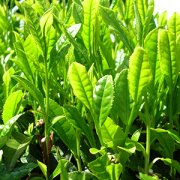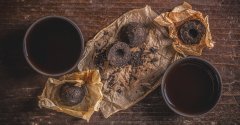What kind of tea is the tea bitten by insects? the origin story and production process of the name of Taiwan puffing tea Oriental Beauty Tea
Miss Nikko sent the tea to the British Tea Fair alone when she had already lost her business. she emotionally introduced Oriental Beauty Tea to the outside world at the last shining moment of her and her father, precisely because of the imperfection of tea. The tea invaded by insects finally became a delicious tea. When the lady just entered the business world, she said: Nikko is not the first tea, but the only one in the tea world. So in reality, how did oriental beauty come from?
Insect bite oolong tea originated in Taiwan in the early 20th century. Once, there were a large number of leafhoppers feasting on a farmer's tea tree. Instead of giving up all the tea he had harvested, he decided to continue to process the tea. As a result, the first oriental beauty oolong tea was born-the predecessor of insect bite tea. The farmer entertained people to drink the tea and was surprised by the feedback. Everyone is fascinated by the unusual sweetness of this tea! The farmer continued to sell tea with great success. Since then, the leafhopper is no longer an unprecedented pest, but a welcome guest! Farmers use "honey fragrance" to describe tea bitten by insects. This means "honey flavor", which refers to the honey sweetness produced by these teas. Why are bugs so important in Oriental Mei Oolong Tea? When bedbugs bite tea, tea trees have a natural defense mechanism. It releases stored sugars and sends them to the bitten area to promote recovery. In addition, some enzymes produced by tea trees further change the overall taste of tea. Interestingly, tea trees respond differently to different pests. Only in leafhoppers (mainly in Taiwan and Japan) does this plant have this special response that makes tea so delicious. Leafhoppers live in warm climates rather than high-altitude tea gardens. Their ideal tea grows at or below 800 meters. However, alpine insects also exist to bite tea. They are usually bitten by other pests, such as aphids. Although the final taste is slightly different, they are still delicious. As for leafhoppers, they are relatively small, about 3 mm. As a result, they naturally leave almost unnoticed bite marks on the tea leaves. Skilled tea farmers will soon find out the difference. However, don't expect to see munching on tea or anything like that. Interestingly, the enzyme produced by tea trees to resist leafhoppers is a special smell that attracts insects that prey on leafhoppers. Humans can also feel this smell. If you have been to the Oriental Beauty Tea Garden, you will notice it immediately. This aroma attracts not only leafhopper predators, but also us humans. Especially us tea tasters! When it comes to enzymes used to resist other pests, we may not be able to smell all the fragrances at the same time!

Insect bites tea ploughing all kinds of vegetation insects bite tea leaves are not as simple as they seem. First of all, the tea garden must be free of pesticides. Otherwise, the tea bug would not have come. However, maintaining a completely pesticide-free garden has its own challenges. It may attract not only the wrong kinds of creatures, but also too many leafhoppers. Too many leafhoppers will destroy the tea. In other words, if you are bitten too much by bugs, the tea will become bitter and not worth selling. In order to ensure a healthy tea garden, farmers must use sustainable farming methods. For example, tea farmers closely monitor the tea garden and pick the tea once it is bitten enough by insects. Taking care of weeds and plants around the tea garden also helps to prevent excess pests. Oriental Beauty Oolong Tea Dongmei is the first oolong tea bitten by insects to be developed and is still the most popular. The first thing you will notice is the beautiful color of the tea, which is a direct result of being bitten by insects. The colors range from green to yellow and brown, reminding us of autumn leaves. This is a very timely time, considering that tea is harvested in summer, and it is most enjoyed when autumn comes. The palate is as sweet as honey with hints of chrysanthemum and ginger. The aroma of champagne and leaves. Most oolong teas bitten by insects undergo more severe oxidation, resulting in a deep, strong flavor. Red oolong tea insect bite red oolong tea is a unique tea variety in Taiwan's Green Leaf Valley, which is located in southeastern Taiwan. Some tea farmers in this area have developed red oolong tea. Green Leaf Valley is at a low altitude, where tea farmers are proud of the attraction of leafhoppers. As a result, most tea producers use organic planting techniques to make the tradition easy to maintain. This kind of tea is unique and mellow. Of course, it has the sweetness of honey and a strong roasting taste. Aromas of ripe fruit.
Important Notice :
前街咖啡 FrontStreet Coffee has moved to new addredd:
FrontStreet Coffee Address: 315,Donghua East Road,GuangZhou
Tel:020 38364473
- Prev

What does Yuji Matcha, one of Japan's three top green tea brands, mean? Yuji Matcha grade
We have talked about the origin of Japanese tea many times before. From the tea tour in Japan to the modern tea ceremony. For example, iced matcha formula. Believe it or not, Japanese elites did not drink iced oat milk matcha lattes in the Edo era. Anyway, today, we're going to show you Yuji in Kyoto, the real Japanese green tea.
- Next

Which tea family does Pu'er tea belong to? Is pu'er black tea or black tea? Water temperature time of Pu'er tea
What is black tea? Black tea is a kind of post-fermented tea, just like Pu'er tea. In fact, Pu'er is essentially black tea. But it's not that simple. Not everyone can tell the difference between happy tea and Pu'er. The English word BlackTea translates to black tea. It is sometimes called black tea to avoid
Related
- Costa tea has a shelf life of 100 years?! Expert: Unable to verify
- It's a huge uproar! American milk addition was rejected by Manner employees?!
- Mocha pot coffee bean recommendations| How fine and how much powder should be used for grinding? What parameter ratios do I need to use to make milk with Mocha pot coffee?
- What are the characteristics of the world's top ten coffee beans treated with Costa Rica honey? How to make black honey kadura from Tarazhu Pilon Processing Plant taste good?
- How to make deep-roasted coffee? What grinding water temperature does authentic Jamaica Blue Mountain No. 1 coffee use to brew it well?
- Selected high-grade rose summer coffee flavor tasting guide Why Panama rose summer has the aroma of flowers and fruits
- What equipment does a novice Xiaobai need to buy to learn to make coffee? Filter cup electronic scale bean grinder manual flushing pot purchase guide
- Stores are closed one after another! Centenary Italian coffee brand Lavazza will withdraw from the Changsha market?!
- Tea Beauty will open a store in Shanghai and Shenzhen?! Netizen: Change the write-off mechanism first
- Fake news! Mixue Ice City employees insulted HR and smashed the store?!

